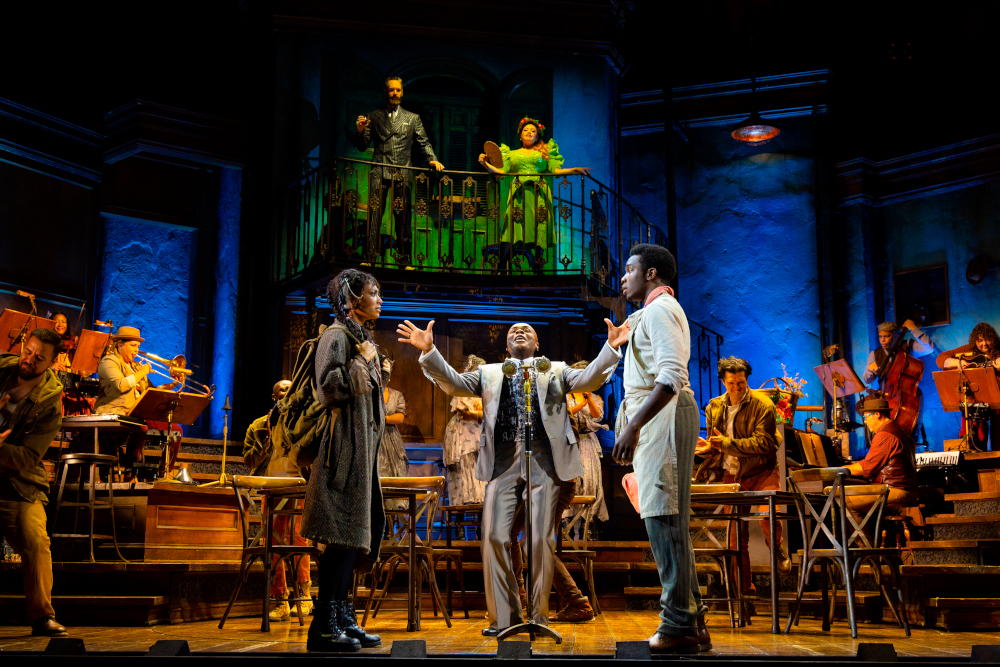
The Tony award-winning Broadway hit HADESTOWN, now on stage at the Fabulous Fox, takes the classic myth of Orpheus, the musician who went to hell and back for his love Eurydice, and transforms it into a energetic, blues-flavored, fantasy tale with a contemporary twist touching on the haves and have-notes, climate change, de-humanizing work and the struggle to just live. Led by a charismatic master-of-ceremonies Hermes (played by the delightful Nathan Lee Graham), HADESTOWN delivers a riveting tale that references the ground-breaking visual style of the silent movie classic “Metropolis” with a touch of steampunk, with its own creative staging and impressive practical effects. After so many stage productions that substitute video projections for real sets and effects, HADESTOWN is a jolt of refreshing creativity.
“Hadestown” opens with a lively, darkly comic musical number, “Road To Hell,” led by an entertaining Hermes (Nathan Lee Graham) as a cafe filled with people parties with a New Orleans sense of fun. There is a dark note under the revelry, a party-while-you-can feeling, that is reflected in charismatic Hermes’ song. Above the cafe’s dance floor, on a balcony, stands the king of the Underworld, Hades (Matthew Patrick Quinn), the wealthy boss of the Hadestown factories where the Workers (Jordan Bollwerk, Lindsey Hailes, Courtney Lauster, Eddie Noel Rodriguez, Jamari Johnson Williams) toil and never leave. Elegantly dressed and with an imperious manner, Hades surveys the human scene, aloof from their concerns. However, his irrepressible, colorfully-dressed wife Persephone (Maria-Christina Oliveras), the goddess of growth, flowering and the harvest, is eager to join the people below, and it is her coming return, along with Spring and Summer, that they are celebrating.
Among the dancing crowd are the three Fates (Dominique Kempf, Belen Moyano, Nyla Watson), playfully devilish spirits who sometimes reveal hints of the future of the human inhabitants. As the people celebrate the coming Spring, a hungry waif-like girl, Eurydice (Hannah Whitley), arrives, looking for something to eat and singing a lament “Any Way the Wind Blows.” Hermes introduces the waif to his ward, a young bard named Orpheus (Chibueze Ihuoma). Orpheus plays the lyre (played here by a guitar), sings and writes beautiful songs that instantly charm the bar’s human patrons. As soon as he sees Eurydice, Orpheus is smitten, and begs her to marry him, singing “Come Home With Me.” Eventually Eurydice agrees to become engaged but before they marry, Orpheus needs to finish the song he is composing, something that will cement his fame and heal the world so no one will be hungry again.
In the cold of winter and facing starvation, hungry Eurydice is persuaded by Hades’ promises of protection to follow him to the Underworld factory and join the Workers. When Orpheus returns and finds her gone, he determine to follow her and bring her back, singing “Wait For Me.”
“Hadestown” is filled with tuneful songs, great costumes, creative physical sets, impressive practical effects, and wonderful performances.
Like “Les Miserables,” “Hadestown” is mostly sung with little spoken dialog, which means it is helpful to know a little of the Greek myth going in. However, “Hadestown” only uses the classic mythology as a starting point to tell a more modern story of class and income divide, building a wall to protect, and of a love that reaches beyond death to dare the impossible.
One of the names for the Greek god Hades is “the wealthy one” and that seems to have inspired some of the story in this re-imagined version of the classic myth of Orpheus and Eurydice. Although he is looking down on earthly life, Hades is the king of the underworld, Hadestown, where his factories staffed by the dead Workers manufacture modern marvels in sweatshop conditions. , produced by slave-like Workers who serve the role of the Greek Chorus, and in this case are the dancers of the production.
“Hadestown” wows with creative staging and well-designed sets, along with athletic dance numbers, terrific songs and some amazing, electrifying stage effects. The practical effects and bits ofos stage magic are much more gripping than anything that can be created with screens and projections, and give the show immediacy and emotional impact. There is a number near the end of the first act, as Orpheus is preparing to go the Underworld to rescue Eurydice, that involves large industrial-style lamps that swing out towards the audience, that is so startling and powerful that it sends a jolt of lightning through the audience. This showstopper is so amazing that it is worth the price of admission itself.
Staging effect include a rectangular space that sometimes resembles an industrial factory elevator or opens up to reveal the headlights of a train, come to take souls to the underworld.
The blues-infused music is terrific, much catchier and tuneful than most modern Broadway musicals, and is played by an on stage band. While the whole cast sings and dances, the highlights are the Workers, whose athletic dance numbers are eye-popping. Their closely choreographed dance numbers around factory work evoke the machine-like human workers of “Metropolis,” which fits well with the industrial workers and wealthy industrialist theme.
“Hadestown” freely mixes myth and symbolism, to create the feeling of contemporary commentary by way of epic story telling, with a heart-tugging romance at its center. There are elements of steampunk in the production’s aesthetic and a good dose of “Metropolis,” along with other references.
This the second outstanding Broadway production that the Fox has staged so far this season, thrilling audiences and setting the stage for one of its best seasons ever,
“Hadestown” is on stage at the Fabulous Fox through Oct 23.
© Cate Marquis
RATING: 5 out of 5 stars